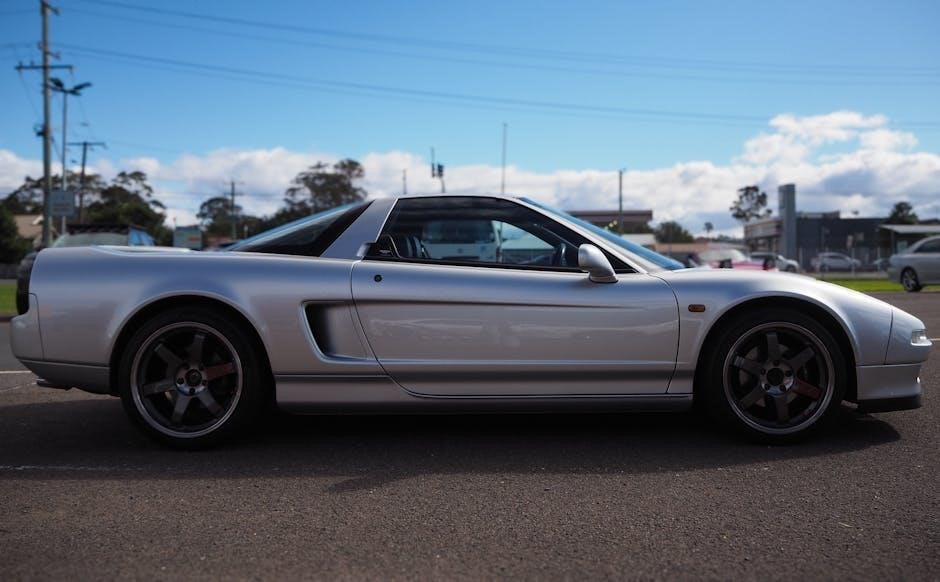Welcome to the 2005 Honda Pilot Owners Manual‚ your comprehensive guide to understanding and maintaining your vehicle. This manual covers essential information about operation‚ maintenance‚ and troubleshooting to ensure optimal performance and safety. By following the guidelines‚ you can enhance your driving experience and preserve your investment.
- Learn about operating controls and features.
- Discover maintenance schedules and procedures.
- Explore troubleshooting tips for common issues.
- Understand safety features and best practices.
Reading this manual will help you maximize your vehicle’s potential and ensure a safe‚ enjoyable journey.
Purpose and Importance of the Manual
The 2005 Honda Pilot Owners Manual is designed to provide owners with essential information for optimal vehicle operation‚ maintenance‚ and safety. Its purpose is to guide users in understanding their vehicle’s features‚ ensuring proper care‚ and addressing common issues. By following the manual‚ drivers can enhance safety‚ performance‚ and longevity of their Honda Pilot. It serves as a comprehensive resource for troubleshooting‚ maintenance schedules‚ and operational guidelines‚ helping owners make informed decisions and enjoy a seamless driving experience while protecting their investment.
- Ensures safe and efficient vehicle operation.
- Provides detailed maintenance and repair guidance.
- Helps owners troubleshoot common issues effectively.
- Supports warranty compliance and vehicle longevity.
Key Features of the 2005 Honda Pilot
The 2005 Honda Pilot is a versatile SUV designed for both comfort and capability. It features a powerful 3.5L V6 engine‚ offering smooth acceleration and reliable performance. The Variable Torque Management 4WD system ensures superior traction and control on various terrains. With seating for up to eight passengers‚ the Pilot provides ample space for families or cargo. Its robust design includes advanced safety features like ABS and dual-stage airbags. The Pilot also boasts a user-friendly interior with intuitive controls‚ making it a practical choice for everyday driving and adventures alike.
- 3.5L V6 engine for strong performance.
- Variable Torque Management 4WD system.
- Spacious seating for up to eight passengers.
- Advanced safety features‚ including ABS.

Vehicle Overview
The 2005 Honda Pilot is a mid-size SUV offering a 3.5L V6 engine‚ seating for eight‚ and a Variable Torque Management 4WD system. It combines versatility with reliability.
- 3.5L V6 engine for robust performance.
- Spacious interior with seating for up to eight.
- 4WD capability for enhanced traction.
- Advanced safety features for secure driving.
2005 Honda Pilot Model Variants
The 2005 Honda Pilot was available in multiple trim levels‚ including LX‚ EX‚ and EX-L‚ offering varying levels of features and upgrades. The LX served as the base model‚ providing essential amenities‚ while the EX added enhancements like a tri-zone climate control and alloy wheels. The EX-L offered premium features‚ including leather-trimmed seating and a DVD entertainment system. Each variant was designed to cater to different preferences‚ ensuring a blend of comfort‚ functionality‚ and performance. The Pilot also came in both two-wheel-drive and four-wheel-drive configurations‚ making it versatile for various driving conditions.
Design and Layout of the Pilot
The 2005 Honda Pilot features a robust SUV design with a focus on comfort and functionality. Its mid-size frame provides ample space for passengers and cargo‚ making it ideal for family use. The interior is thoughtfully laid out‚ with a user-friendly dashboard‚ easy-to-read instrumentation‚ and convenient storage compartments. The Pilot’s exterior combines a rugged aesthetic with practical elements like a rear spoiler and alloy wheels‚ enhancing both style and performance. The design emphasizes versatility‚ offering a spacious cabin with seating for up to eight passengers and foldable rear seats for expanded cargo capacity.

Instrument Panel and Controls
The 2005 Honda Pilot’s instrument panel features a central dashboard with intuitive controls for climate‚ audio‚ and navigation systems‚ ensuring easy access and operation while driving.
Understanding the Dashboard and Gauges
The dashboard of the 2005 Honda Pilot is designed for clarity and functionality. Analog gauges provide essential information‚ including speed‚ engine RPM‚ fuel level‚ and coolant temperature. Digital displays show additional data such as odometer‚ trip meter‚ and ambient temperature. The instrument cluster also features warning lights for system malfunctions‚ ensuring timely driver alerts. The multi-information display allows customization‚ offering insights into fuel efficiency and maintenance reminders. The intuitive layout ensures drivers can monitor vital systems without distraction‚ promoting safe and informed driving experiences.
Operating the Heating and Air Conditioning Systems
The 2005 Honda Pilot’s heating and air conditioning systems are controlled via the dashboard panel. The climate control buttons and knobs allow you to adjust temperature‚ fan speed‚ and airflow direction. The system includes settings for defrost‚ air conditioning‚ and recirculation modes. To defrost windows‚ select the defrost mode and ensure the air conditioning is on to remove moisture. For optimal comfort‚ adjust the temperature and fan speed as needed. Proper airflow settings help maintain clear visibility and prevent fogging. Regularly cleaning air vents ensures efficient performance and fresh air circulation inside the vehicle.

Maintenance and Service Schedule
The 2005 Honda Pilot requires regular maintenance to ensure optimal performance and longevity. Follow the recommended schedule for oil changes‚ tire rotations‚ and inspections to maintain reliability and safety.
Recommended Maintenance Intervals
To keep your 2005 Honda Pilot in top condition‚ follow the recommended maintenance intervals. Oil changes are needed every 5‚000 miles‚ while tire rotations should occur every 7‚500 miles. The air filter should be replaced every 15‚000 miles‚ and the spark plugs every 30‚000 miles. Brake fluid should be changed every 30‚000 miles‚ and the timing belt replaced at 105‚000 miles. Adhering to these intervals ensures optimal performance‚ prevents wear‚ and avoids costly repairs. Always refer to the owner’s manual for specific guidelines tailored to your driving conditions‚ such as severe-duty schedules for extreme temperatures or towing.
Importance of Regular Servicing
Regular servicing is essential for maintaining your 2005 Honda Pilot’s performance‚ reliability‚ and longevity. It helps prevent mechanical failures‚ reduces repair costs‚ and ensures safety on the road. Routine checks catch potential issues early‚ avoiding breakdowns and extending the vehicle’s lifespan. Servicing also optimizes fuel efficiency‚ enhances engine performance‚ and preserves the resale value. Additionally‚ it ensures compliance with manufacturer guidelines‚ which may be required for warranty coverage. Always follow the recommended schedule to keep your Pilot running smoothly and safely. Regular maintenance is a proactive approach to protecting your investment and ensuring years of trouble-free driving.

Safety Features and Precautions
The 2005 Honda Pilot features robust safety systems designed to protect occupants. Adherence to safety guidelines and regular checks ensure optimal protection and reliability on the road.
Understanding Airbags and Seatbelts
The 2005 Honda Pilot is equipped with a comprehensive airbag system‚ including dual front airbags and side airbags for enhanced occupant protection. Seatbelts are designed to work in conjunction with airbags‚ ensuring maximum safety during collisions. Proper use of seatbelts is essential‚ as they help prevent ejection and reduce injury risk. Always wear the seatbelt correctly‚ with the lap belt snug across the hips and the shoulder belt across the chest. Never modify or tamper with the airbag or seatbelt systems‚ as this can compromise safety. Refer to the manual for guidance on child restraints and airbag-related warnings.
Anti-lock Braking System (ABS) and Traction Control
The 2005 Honda Pilot features an Anti-lock Braking System (ABS) to prevent wheel lock-up during hard braking‚ ensuring better control and stopping performance. Traction Control helps maintain stability by reducing wheel spin on slippery surfaces. Both systems operate automatically‚ enhancing safety without driver intervention. However‚ ABS and Traction Control are not substitutes for cautious driving. Avoid disabling these systems‚ as they are critical for optimal vehicle stability. If the ABS or Traction Control lights illuminate‚ consult the manual or a Honda technician to address potential issues. These systems work seamlessly to improve safety and driving confidence in various road conditions.

Driving Tips and Guidelines
Always wear seatbelts and ensure all passengers do the same. Avoid distractions while driving‚ keep eyes on the road‚ and maintain safe following distances. Adjust speed according to weather and road conditions. Use signals consistently and be mindful of surrounding traffic. Regularly check mirrors for awareness. Drive smoothly to optimize fuel efficiency and reduce wear on the vehicle. Be cautious in low visibility and adverse weather. Keep the vehicle well-maintained for reliability and performance. Follow traffic laws and practice defensive driving habits to enhance safety on the road.
Optimizing Fuel Efficiency
To maximize fuel efficiency in your 2005 Honda Pilot‚ maintain consistent speeds and avoid aggressive acceleration. Keep tires properly inflated‚ as underinflated tires reduce mileage. Remove unnecessary weight from the vehicle‚ as extra load decreases efficiency. Use the air conditioning sparingly‚ as it can increase fuel consumption. Plan trips to avoid traffic congestion and excessive idling. Regularly servicing the vehicle‚ including air filter replacements‚ ensures optimal performance. Driving smoothly and within speed limits helps conserve fuel. By following these tips‚ you can enjoy better mileage and lower fuel costs while driving your Honda Pilot.
Safe Driving Practices
Always wear your seatbelt and ensure all passengers do the same. Keep a safe distance from other vehicles to allow ample reaction time. Avoid distractions like using your phone while driving. Be aware of your surroundings and check mirrors frequently. Use turn signals consistently to communicate your intentions. Drive at appropriate speeds for road conditions and reduce speed in poor weather. Keep your eyes on the road and stay alert‚ especially in heavy traffic or construction zones. Following these practices helps protect you‚ your passengers‚ and others on the road.

Troubleshooting Common Issues
Consult the manual for guidance on diagnosing issues like warning lights or mechanical problems. Address concerns promptly to prevent further damage and ensure safe operation.
Identifying and Solving Basic Problems
The 2005 Honda Pilot Owner’s Manual provides detailed guidance for identifying and resolving common issues. Start by checking the dashboard warning lights‚ as they often indicate specific problems. For example‚ the “Check Engine” light may signal issues with the emissions system. Consult the manual to understand the meaning of each light. Basic issues like a dead battery or flat tire can be addressed using the troubleshooting section. Always refer to the manual before attempting repairs. If a problem persists‚ contact a certified Honda technician for professional assistance.
Warning Lights and Indicators
The 2005 Honda Pilot features a range of warning lights and indicators on the dashboard to alert drivers of potential issues. These include the oil pressure light‚ battery charge light‚ and engine light. Each light corresponds to specific system malfunctions. Amber-colored lights often indicate maintenance needs‚ while red lights signal urgent issues requiring immediate attention. Consult the owner’s manual to understand the meaning of each light. If a light illuminates‚ check the manual for guidance or visit a certified Honda technician to address the problem promptly and ensure vehicle safety.

Technical Specifications
The 2005 Honda Pilot features a 3.5L V6 engine‚ producing 240 horsepower‚ with a 5-speed automatic transmission. It offers front-wheel or all-wheel drive‚ weighing around 4‚400 lbs.
Engine and Transmission Details
The 2005 Honda Pilot is equipped with a 3.5L V6 engine‚ delivering 240 horsepower at 5‚400 rpm. It features a 5-speed automatic transmission with Grade Logic Control for smooth shifting. The engine utilizes a Single Overhead Camshaft (SOHC) design with 24 valves and Variable Valve Timing and Lift Electronic Control (VTEC) for enhanced performance. The Pilot offers both front-wheel drive (FWD) and all-wheel drive (AWD) configurations‚ providing versatility for various driving conditions. The engine also includes a multi-point fuel injection system for efficient combustion.
The Pilot’s torque output is 242 lb-ft at 4‚500 rpm‚ ensuring strong towing and hauling capability. The fuel tank capacity is 19 gallons‚ supporting extended trips. The engine meets strict emissions standards with its advanced catalytic converter system. These specifications make the 2005 Honda Pilot a reliable and powerful choice for both on-road and off-road adventures.
Performance and Capacities
The 2005 Honda Pilot offers impressive performance and capabilities‚ making it a versatile SUV for various needs. Its maximum towing capacity reaches up to 4‚500 pounds when properly equipped‚ ideal for trailers or boats. The vehicle has a curb weight of approximately 4‚300 pounds‚ ensuring stability on the road. The maximum payload capacity is around 1‚600 pounds‚ allowing for heavy cargo. The fuel tank holds 19 gallons‚ providing a range of over 400 miles on a single fill. These specifications ensure the Pilot is both practical and reliable for everyday use and outdoor adventures.

Warranty and Support Information
The 2005 Honda Pilot comes with a comprehensive warranty and dedicated support services. Owners can access 24/7 customer assistance‚ online resources‚ and a reliable support network.
Understanding Your Vehicle Warranty
Your 2005 Honda Pilot is backed by a comprehensive warranty program designed to protect your investment. The new vehicle warranty covers parts and labor for defects in materials and workmanship. Key components like the powertrain are covered for an extended period‚ while emissions-related parts have a longer warranty. Regular maintenance is essential to maintain warranty eligibility. The manual provides detailed information on warranty terms‚ including what is covered‚ duration‚ and any limitations. Always refer to the manual for specific details on maintaining your warranty and addressing any potential issues promptly.
Contacting Honda Customer Support
For assistance with your 2005 Honda Pilot‚ contact Honda Customer Support through various channels. Visit the official Honda website for contact information‚ including phone numbers‚ email‚ and live chat options. You can also reach support by calling the Honda Customer Service hotline‚ available 24/7. Have your Vehicle Identification Number (VIN) ready for faster service. Additionally‚ local Honda dealerships can provide personalized support and address specific concerns. Always refer to the manual or Honda’s official resources for the most accurate and up-to-date contact details. Prompt assistance ensures your vehicle remains in optimal condition.

Final Tips for Enjoying Your 2005 Honda Pilot
Enjoy your 2005 Honda Pilot with confidence by following the manual’s guidelines. Regular maintenance ensures safety‚ performance‚ and a lasting driving experience. Happy adventuring!
To maximize your enjoyment of the 2005 Honda Pilot‚ familiarize yourself with its features and personalize settings to suit your preferences. Regularly review the owner’s manual to stay informed about maintenance‚ safety‚ and optimal performance. Keep the manual in an accessible location for quick reference. Explore the vehicle’s capabilities‚ such as towing and off-road driving‚ while adhering to guidelines. Invest in genuine Honda parts for repairs to maintain reliability. Lastly‚ embrace safe driving practices and take pride in owning a versatile‚ dependable SUV designed for adventure and everyday convenience.
